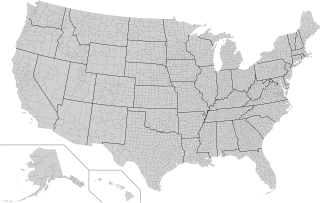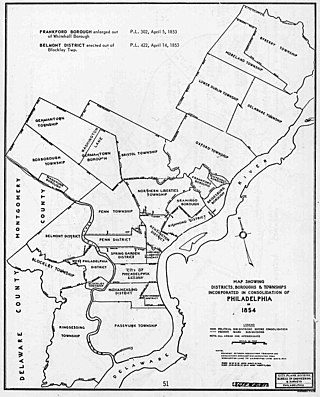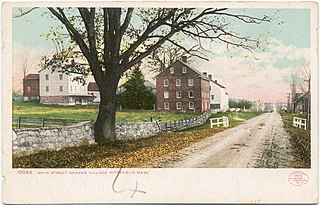This article needs additional citations for verification .(May 2018) |
Legal nullity refers to any entity which theoretically is, or might be, of some legal significance, but in fact lacks any identity or distinct structure of its own. [1]
This article needs additional citations for verification .(May 2018) |
Legal nullity refers to any entity which theoretically is, or might be, of some legal significance, but in fact lacks any identity or distinct structure of its own. [1]
The usual examples are counties (or equivalent sub-regional groupings) which are wholly subsumed by the municipal government within their boundaries. [1]
Some entities which fit this description are Philadelphia County, a legal nullity because it is entirely coterminous with the city of Philadelphia, Pennsylvania, and New York County, which is similarly coterminous with the Borough of Manhattan, in New York City (as each of the five Boroughs of New York City is coterminous with a county). [1] Similarly, the eight counties of Connecticut have only a shadow existence: virtually all of their governmental functions were abolished in 1960, the rest in 2000. Their historic boundaries are used only to organize certain state level police and judicial districts.
These areas are of relatively little legal import, since there is a generally agreed overarching legal coverage. The issue is of greater significance when a significant power is technically under the overarching body's power but has been external from that control for so long that it is generally accepted as to have little consequence. Kosovo is one particular case, as from many countries' viewpoints, it doesn't exist as a country. However it has a well-established legal system without any other party effectively stating control over the region (and no likelihood of that changing in the anticipated future). For the 80 countries that don't recognise its independence, but wish to participate with the country (trade, security etc.), then functioning with Kosovo's legal system is necessary. This means functionally ignoring a legal system of significance, from their point of view. The same can be said of several other long-disputed "de facto" States, where necessity drives rejecting the participation of a legally significant legal system. [1]
Legal nullity is also a court decision made without jurisdiction or authority. Such a decision does not have to be vacated or appealed, it is void from inception.[ citation needed ]
A county is a geographic region of a country used for administrative or other purposes in some nations. The term is derived from the Old French comté denoting a jurisdiction under the sovereignty of a count (earl) or a viscount. Literal equivalents in other languages, derived from the equivalent of "count", are now seldom used officially, including comté, contea, contado, comtat, condado, Grafschaft, graafschap, and zhupa in Slavic languages; terms equivalent to 'commune' or 'community' are now often instead used.

A town is a type of a human settlement. Towns are generally larger than villages and smaller than cities, though the criteria to distinguish between them vary considerably in different parts of the world.

In the United States, a county or county equivalent is an administrative or political subdivision of a U.S. state or other territories of the United States which consists of a geographic area with specific boundaries and usually some level of governmental authority. The term "county" is used in 48 states, while Louisiana and Alaska have functionally equivalent subdivisions called parishes and boroughs, respectively. The specific governmental powers of counties vary widely between the states, with many providing some level of services to civil townships, municipalities, and unincorporated areas. Certain municipalities are in multiple counties; New York City is uniquely partitioned into five counties, referred to at the city government level as boroughs. Some municipalities have been consolidated with their county government to form consolidated city-counties, or have been legally separated from counties altogether to form independent cities. Conversely, counties in Connecticut, Rhode Island, eight of Massachusetts's 14 counties, and Alaska's Unorganized Borough have no government power, existing only as geographic distinctions.
In United States local government, a consolidated city-county is formed when one or more cities and their surrounding county merge into one unified jurisdiction. As such it is a type of unitary authority that has the governmental powers of both a municipal corporation and a county.
A civil township is a widely used unit of local government in the United States that is subordinate to a county, most often in the northern and midwestern parts of the country. The term town is used in New England, New York, as well as Wisconsin to refer to the equivalent of the civil township in these states; Minnesota uses "town" officially but often uses it and "township" interchangeably. Specific responsibilities and the degree of autonomy vary in each state. Civil townships are distinct from survey townships, but in states that have both, the boundaries often coincide and may completely geographically subdivide a county. The U.S. Census Bureau classifies civil townships as minor civil divisions. Currently, there are 20 states with civil townships.

The administrative divisions of New York are the various units of government that provide local services in the American state of New York. The state is divided into boroughs, counties, cities, towns, and villages. They are municipal corporations, chartered (created) by the New York State Legislature, as under the New York State Constitution the only body that can create governmental units is the state. All of them have their own governments, sometimes with no paid employees, that provide local services. Centers of population that are not incorporated and have no government or local services are designated hamlets. Whether a municipality is defined as a borough, city, town, or village is determined not by population or land area, but rather on the form of government selected by the residents and approved by the New York State Legislature. Each type of local government is granted specific home rule powers by the New York State Constitution. There are still occasional changes as a village becomes a city, or a village dissolves, each of which requires legislative action. New York also has various corporate entities that provide local services and have their own administrative structures (governments), such as school and fire districts. These are not found in all counties.
In England, a township is a local division or district of a large parish containing a village or small town usually having its own church. A township may or may not be coterminous with a chapelry, manor, or any other minor area of local administration.

Most U.S. states and territories have at least two tiers of local government: counties and municipalities. Louisiana uses the term parish and Alaska uses the term borough for what the U.S. Census Bureau terms county equivalents in those states. Civil townships or towns are used as subdivisions of a county in 20 states, mostly in the Northeast and Midwest.

The Act of Consolidation, more formally known as the act of February 2, 1854, is legislation of the Pennsylvania General Assembly that created the consolidated City and County of Philadelphia, expanding the city's territory to the entirety of Philadelphia County and dissolving the other municipal authorities in the county.
The borough presidents are the chief executives of the five boroughs of New York City. For most of the city's history, the office exercised significant executive powers within each borough, and the five borough presidents also sat on the New York City Board of Estimate. Since 1990, the borough presidents have been stripped of a majority of their powers in the government of New York City.
A municipal council is the legislative body of a municipality or local government area. Depending on the location and classification of the municipality it may be known as a city council, town council, town board, community council, rural council, village council, or board of aldermen.
The administrative divisions of Virginia are the areas into which the Commonwealth of Virginia, a U.S. state, is divided for political and administrative purposes. Some are local governments; others are not. However, all local governments are political subdivisions of the state.

In the United States, the meaning of village varies by geographic area and legal jurisdiction. In formal usage, a "village" is a type of administrative division at the local government level. Since the Tenth Amendment to the United States Constitution prohibits the federal government from legislating on local government, the states are free to have political subdivisions called "villages" or not to and to define the word in many ways. Typically, a village is a type of municipality, although it can also be a special district or an unincorporated area. It may or may not be recognized for governmental purposes.
The United States Census Bureau defines a place as a concentration of population which has a name, is locally recognized, and is not part of any other place. A place typically has a residential nucleus and a closely spaced street pattern, and it frequently includes commercial property and other urban land uses. A place may be an incorporated place or it may be a census-designated place (CDP). Incorporated places are defined by the laws of the states in which they are contained. The Census Bureau delineates CDPs. A small settlement in the open countryside or the densely settled fringe of a large city may not be a place as defined by the Census Bureau. As of the 1990 census, 26% of the people in the United States lived outside of places.
Local government in Pennsylvania is government below the state level in Pennsylvania. There are six types of local governments listed in the Pennsylvania Constitution: county, township, borough, town, city, and school district. All of Pennsylvania is included in one of the state's 67 counties, which are in total subdivided into 2,560 municipalities. There are currently no independent cities or unincorporated territories within Pennsylvania. There is only one incorporated town in Pennsylvania, Bloomsburg.
City limits or city boundaries refer to the defined boundary or border of a city. The area within the city limit can be called the city proper. Town limit/boundary and village limit/boundary apply to towns and villages. Similarly, corporate limit is a legal name that refers to the boundary of municipal corporations. In some countries, the limit of a municipality may be expanded through annexation.
In the United States, an independent city is a city that is not in the territory of any county or counties and is considered a primary administrative division of its state. Independent cities are classified by the United States Census Bureau as "county equivalents" and may also have similar governmental powers to a consolidated city-county or a unitary authority. However, in the case of a consolidated city-county, a city and a county were merged into a unified jurisdiction in which the county at least nominally exists to this day, whereas an independent city was legally separated from any county or merged with a county that simultaneously ceased to exist even in name.
A coterminous municipality, sometimes also known as a coterminous city or a coterminous town-village, is a form of local government in some U.S. states in which a municipality and one or more civil townships have partial or complete consolidation of their government functions. A term used for the formation of such a local government is "township and municipal consolidation." This form of local government is distinct from a municipality coterminous with a higher level of government, which is called a consolidated city-county or a variation of that term.